or: How Close to a Kangaroo do You Think You Can Get?
“I’m sure I’ll eventually get tired of seeing all these kangaroos, but for now I just can’t get enoug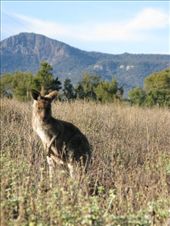 h of them,” I said, as I apologetically snapped off a few more pictures at one of my many kangaroo photo sessions. It seems that we’ve happened upon a mecca for wildlife here in Warrumbungle National Park.
h of them,” I said, as I apologetically snapped off a few more pictures at one of my many kangaroo photo sessions. It seems that we’ve happened upon a mecca for wildlife here in Warrumbungle National Park.
In Northwest New South Wales, Lonely Planet describes Warrumbungle National Park as being one of the two tourist attractions (Lightning Ridge being the other) along this stretch of highway usually reserved for trips straight to and from Queensland. But for a tourist attraction, Warrumbungle appears to be the best kept secret from tourists.
“Usually in the summertime it’s too hot so people go to the coast,” said the park ranger who was processing our camping fees. “And in the wintertime like now, it’s too cold for many,” she said, when we asked if we would have trouble finding a camping spot for the weekend. “You’ll pretty much have the place to yourselves.”

And we did.
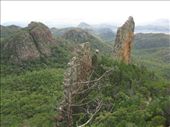
It did however get bloody cold at night – no big surprise for us by now. Armed with blankets and many layers of clothing, the cold at night was bearable. And the beauty and warmth of the days made the nights all the more tempered for us. We were constantly amazed that we had so much of this unbelievably beautiful national park substantially to ourselves.
Immediately we saw kangaroos everywhere. We passed no less than a dozen of them grazing by the side of the road between the visitor centre and our campsite a short distance away. And every time I saw one I clapped my hands in glee.
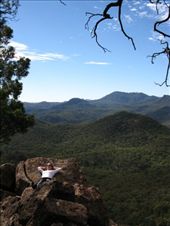 We set up camp and enjoyed watching the kangaroos graze not twenty meters away from us. Photo sessions began, and there was much clapping of hands in glee. At sunset, we heard what was now becoming the commonplace symphony of birdsong (including the ape-like cackle of the kookaburra and the deafening prehistoric sounding scream of the cockatoo), and at night, we could hear the low belch-like grunts of emus grazing all around us.
We set up camp and enjoyed watching the kangaroos graze not twenty meters away from us. Photo sessions began, and there was much clapping of hands in glee. At sunset, we heard what was now becoming the commonplace symphony of birdsong (including the ape-like cackle of the kookaburra and the deafening prehistoric sounding scream of the cockatoo), and at night, we could hear the low belch-like grunts of emus grazing all around us.
Arising (and defrosting) the following morning, we saw yet more kangaroos hopping around our van, and there was more gleeful clapping of hands and photo sessions.
Our treks through the park over the following two days were incredible. Warrumbungle is the remnants of a volcanic explosion that took place almost 17 million years ago, leaving 1,000 meter 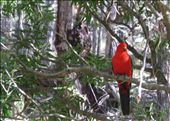 high granite spires and domes poking out amongst an otherwise flat landscape all around. The life that pulses through the lush green valleys in between is evident everywhere. Birds of all kinds (gosh, we love the colourful Aussie birds), goats (gosh, we miss the goats in Hawaii), emus, koalas (although we didn’t see any), and of course – kangaroos.
high granite spires and domes poking out amongst an otherwise flat landscape all around. The life that pulses through the lush green valleys in between is evident everywhere. Birds of all kinds (gosh, we love the colourful Aussie birds), goats (gosh, we miss the goats in Hawaii), emus, koalas (although we didn’t see any), and of course – kangaroos.
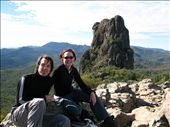 We trekked over peaks and through valleys, journeying about 30kms over the two days. We regularly caught ourselves forgetting that we weren’t in Canada since much of the scenery was similar, and only upon seeing an intrinsically Australian animal would we be reminded of where we are. And how lucky we are to be here.
We trekked over peaks and through valleys, journeying about 30kms over the two days. We regularly caught ourselves forgetting that we weren’t in Canada since much of the scenery was similar, and only upon seeing an intrinsically Australian animal would we be reminded of where we are. And how lucky we are to be here.
Finishing off our second day’s hike, feeling tired and sore but elated, we were deep in conversation when I stopped cold, Kelly crashing into me. This time it wasn’t a snake; it was a kangaroo. Standing upright in the middle of the path, less than three meters away from us, it was eyeing us up and down. We stood there in a stand-off of sorts, for about a minute. Then, seeing as the kangaroo was directly in our way and still sniffing at us in a non-threatening  manner, we inched forward, expecting it to hop away so we could continue along the path.
manner, we inched forward, expecting it to hop away so we could continue along the path.
Instead, as we inched forward, the kangaroo became even less concerned about our presence, shook its head and flopped its ears, and knelt down to graze at the grass right on the path.
And so we stood for what seemed like ages, trying to discern what proper “kangaroo etiquette” should dictate we do. Do we give it a wide berth and walk around? That was tricky to do given the trail we were on. Do we make a loud noise to startle it so it would hop away? We didn’t want to scare it into attacking us though (because you know how ferocious kangaroos can get. Right). Or do we just charge ahead and expect the kangaroo to move out of the way?
This indecision requires an explanation: See, in Canada, there aren’t many wild creatures that are content to coexist with humans at such close proximity. Deer are probably the most docile (similar to kangaroos), but you should consider yourself lucky to get 20 meters from a deer before it darts off into the bush. Bears aren’t animals you particularly want to get close to (for obvious reasons). And moose simply don’t exist.
So to be this close to a wild animal was perplexing for us. I even hesitated from launching into my routine gleeful clapping of hands for my confusion.
Luckily, the kangaroo did eventually choose to take action and interrupted our indecision by nonchalantly hopping away so we could continue on our way back to the van.
Once in the van and enroute to camp, we were deep in reflection of our last two days of hikes when the unbelievable happened; we stopped the van cold.
In front of us, a mother and daughter were standing next to a kangaroo, who was casually looking off into the distance while the daughter was stroking its back. Of course, the camera came out again, pictures were snapped, and hands were being euphorically clapped and accompanied by 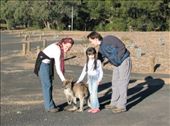 stifled giggles of joy.
stifled giggles of joy.
The mother then encouraged us to come out and join them, as she assured us that the kangaroo wouldn’t go anywhere. Sure enough, as we slowly approached it, the kangaroo gently hopped to us to investigate, then presented its head and back for scratching. Amazing.
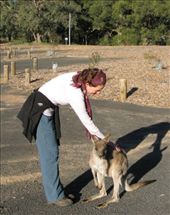 We decided that this wild kangaroo must have been an orphan that was raised by humans until it was old enough to be released, where it joined other wild kangaroos, but occasionally craved some familiar human affection. Sue, one of the park rangers who we befriended over our stay, rescues kangaroos (among the array of other wild animals that tend to be dropped off on her doorstep for saving). She showed us the joey she brings into work with her in a little custom pouch. This joey, being so familiar with human contact, would be released once it was a little over a year old, after being in her care for over seven months. So it stands to reason that the occasional kangaroo in the park might be tamer than the rest.
We decided that this wild kangaroo must have been an orphan that was raised by humans until it was old enough to be released, where it joined other wild kangaroos, but occasionally craved some familiar human affection. Sue, one of the park rangers who we befriended over our stay, rescues kangaroos (among the array of other wild animals that tend to be dropped off on her doorstep for saving). She showed us the joey she brings into work with her in a little custom pouch. This joey, being so familiar with human contact, would be released once it was a little over a year old, after being in her care for over seven months. So it stands to reason that the occasional kangaroo in the park might be tamer than the rest.
Having gotten as close as you possibly can to a kangaroo, our trip through Warrumbungle National Park was climactically complete. We spent the evening with our new friends Wendy and Vern (and their daughter Clarissa, who was the lucky kangaroo-attracter-and-petter), who we will see more of when we get down to the Melbourne area where they live.
Next stop: Lightning Ridge!